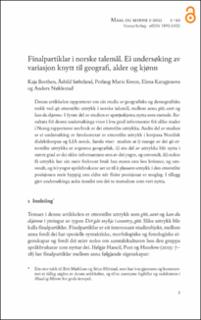| dc.contributor.author | Borthen, Kaja | |
| dc.contributor.author | Søfteland, Åshild | |
| dc.contributor.author | Kveen, Perlaug Marie | |
| dc.contributor.author | Karagjosova, Elena | |
| dc.contributor.author | Nøklestad, Anders | |
| dc.date.accessioned | 2021-06-16T10:26:38Z | |
| dc.date.available | 2021-06-16T10:26:38Z | |
| dc.date.created | 2021-06-14T21:52:51Z | |
| dc.date.issued | 2021 | |
| dc.identifier.citation | Maal og Minne. 2021, 113 (1), 1-63. | en_US |
| dc.identifier.issn | 0024-855X | |
| dc.identifier.uri | https://hdl.handle.net/11250/2759735 | |
| dc.description.abstract | Denne artikkelen rapporterer om ein studie av geografiske og demografiske trekk ved 46 etterstilte uttrykk i norske talemål, mellom anna gitt, sant og kan du skjønne. I fyrste del av studien er spørjeskjema nytta som metode. Resultata frå denne undersøkinga viser i kva grad informantar frå ulike stader i Noreg rapporterer om bruk av dei etterstilte uttrykka. Andre del av studien er ei undersøking av førekomstar av etterstilte uttrykk i korpusa Nordisk dialektkorpus og LIA norsk. Samla viser studien at i) mange av dei 46 etterstilte uttrykka er avgrensa geografisk, ii) ein del av uttrykka blir nytta i større grad av dei eldre informantane enn av dei yngre, og omvendt, iii) nokre få uttrykk har ein meir frekvent bruk hos menn enn hos kvinner, og omvendt, og iv) yngre språkbrukarar ser ut til å plassere uttrykk i den etterstilte posisjonen meir hyppig enn eldre når fleire posisjonar er mogleg. I tillegg gjev undersøkinga auka innsikt om dei to metodane som vart nytta. | en_US |
| dc.description.abstract | This article reports on a study of geographical and demographical aspects of 46 final particles in Norwegian dialects, among them gitt (< lit.‘boy’), sant (< lit. ‘true’) and kan du skjønne (< lit. ‘can you realize’). In the first part of the study, a questionnaire was used as the method. The results from this study show to what extent informants from different regions in Norway report on use of the given final particles. The second part of the study is an investigation of the use of the 46 final particles in the corpora Nordisk dialektkorpus and LIA norsk. In sum, the study shows that i) many of the 46 final particles are delimited geographically; ii) some of the expressions are used to greater extent by the older informants than by the younger ones, and the other way around; iii) a few expressions have a more frequent use among men than among women, and the other way around, and iv) overall, younger people seem to place expressions in the final (tag) position more often than do older people when more than one syntactic position is possible. In addition, the study contributes insights into the two methods that were used. | en_US |
| dc.language.iso | nno | en_US |
| dc.publisher | Novus Forlag | en_US |
| dc.relation.uri | http://ojs.novus.no/index.php/MOM/article/view/1950 | |
| dc.rights | Navngivelse-DelPåSammeVilkår 4.0 Internasjonal | * |
| dc.rights.uri | http://creativecommons.org/licenses/by-sa/4.0/deed.no | * |
| dc.title | Finalpartiklar i norske talemål: Ei undersøking av variasjon knytt til geografi, alder og kjønn | en_US |
| dc.type | Peer reviewed | en_US |
| dc.type | Journal article | en_US |
| dc.description.version | publishedVersion | en_US |
| dc.rights.holder | Opphavsrett 2021 Forfatterne. | en_US |
| dc.subject.nsi | VDP::Humaniora: 000::Språkvitenskapelige fag: 010::Nordiske språk: 018 | en_US |
| dc.source.pagenumber | 1-63 | en_US |
| dc.source.volume | 113 | en_US |
| dc.source.journal | Maal og Minne | en_US |
| dc.source.issue | 1 | en_US |
| dc.identifier.cristin | 1915746 | |
| dc.relation.project | Norges forskningsråd: 230782 | en_US |
| cristin.ispublished | true | |
| cristin.fulltext | original | |
| cristin.qualitycode | 2 | |

